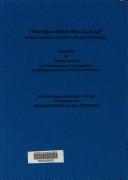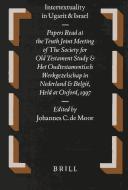| Listing 1 - 2 of 2 |
Sort by
|

ISBN: 392712060X 9783927120600 Year: 1998 Volume: 250 Publisher: Münster : Ugarit-Verlag,
Abstract | Keywords | Export | Availability | Bookmark
 Loading...
Loading...Choose an application
- Reference Manager
- EndNote
- RefWorks (Direct export to RefWorks)
Ugaritic literature --- Littérature ougaritique. --- History and criticism --- Relation to the Old Testament. --- Histoire et critique --- Relation avec l'Ancien Testament --- Bible. --- Criticism, interpretation, etc. --- Relation to the Old Testament --- Bible --- Criticism, interpretation, etc --- -Ugaritic literature --- -History and criticism --- Littérature ougaritique. --- Antico Testamento --- Hebrew Bible --- Hebrew Scriptures --- Kitve-ḳodesh --- Miḳra --- Old Testament --- Palaia Diathēkē --- Pentateuch, Prophets, and Hagiographa --- Sean-Tiomna --- Stary Testament --- Tanakh --- Tawrāt --- Torah, Neviʼim, Ketuvim --- Torah, Neviʼim u-Khetuvim --- Velho Testamento --- History and criticism. --- Ugaritic literature - History and criticism --- Ugaritic literature - Relation to the Old Testament

ISSN: 01697226 ISBN: 9004111549 9004493980 9789004111547 9789004493988 Year: 1998 Volume: 40 Publisher: Leiden Brill
Abstract | Keywords | Export | Availability | Bookmark
 Loading...
Loading...Choose an application
- Reference Manager
- EndNote
- RefWorks (Direct export to RefWorks)
In modern literary studies intertextuality is at the centre of interest. Although the relationship between texts has always been an important aspect of Old Testament studies, especially in literary criticism, the scale of comparison has broadened, including for example the interrelationships between the First, Second and Third Isaiah, or the whole Book of the Twelve. These relatively new approaches raise a number of methodical questions which were addressed at the Tenth Joint Meeting of the British Society for Old Testament Study and the Dutch 'Oudtestamentisch Werkgezelschap', held at Oxford, 22nd to 25th July 1997. Did the ancient authors have a well-defined concept of a book? How did they relate to the literary work of their predecessors and contemporaries? Can we trace the theological motifs behind their use of other literary compositions? What does an ancient version reveal about the way it interpreted its source text? One of the problems confronting biblical scholars in this kind of research is the lack of controllable models. Therefore it is useful to study the work of the Ugaritic chief priest Ilimilku whose three major literary compositions provide us with a unique possibility to monitor intertextual relationships in the work of one and the same ancient author. Ugaritic and other ancient Near Eastern parallels help us to understand how the Priestly writer re-interpreted the Yahwistic account of the creation of mankind. Apparently intertextuality in Israel is a phenomenon which cannot properly be understood without taking other literature from the ancient world into account.
Intertextuality in the Bible --- Ugaritic literature --- 221.015 --- 221.015 Oud Testament: literaire kritiek; authenticiteit; bronnenstudie; Formgeschiche; Traditionsgeschichte; Redaktionsgeschichte --- Oud Testament: literaire kritiek; authenticiteit; bronnenstudie; Formgeschiche; Traditionsgeschichte; Redaktionsgeschichte --- Relation to the Old Testament --- Bible. --- Antico Testamento --- Hebrew Bible --- Hebrew Scriptures --- Kitve-ḳodesh --- Miḳra --- Old Testament --- Palaia Diathēkē --- Pentateuch, Prophets, and Hagiographa --- Sean-Tiomna --- Stary Testament --- Tanakh --- Tawrāt --- Torah, Neviʼim, Ketuvim --- Torah, Neviʼim u-Khetuvim --- Velho Testamento --- Criticism, interpretation, etc. --- Ugaritic literature - Relation to the Old Testament - Congresses --- Intertextuality in the Bible - Congresses --- Bible AT --- Littérature ougaritique --- Intertextualité --- Herméneutique --- Critique, interprétation, etc --- Relation avec l'Ancien Testament --- Aspect religieux
| Listing 1 - 2 of 2 |
Sort by
|

 Search
Search Feedback
Feedback About UniCat
About UniCat  Help
Help News
News